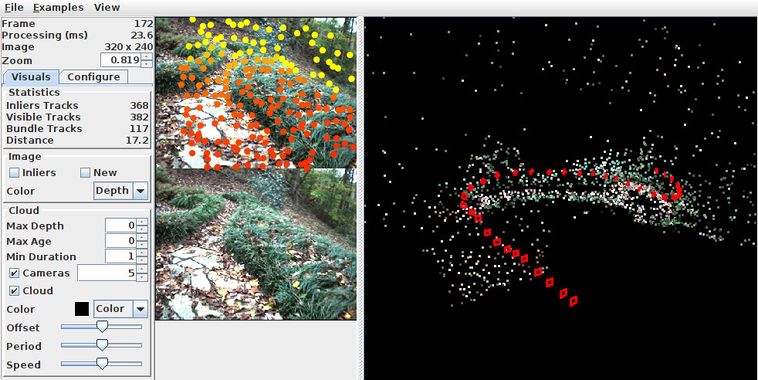Example Stereo Visual Odometry
From BoofCV
Jump to navigationJump to searchStereo visual odometry estimates the camera's egomotion using a pair of calibrated cameras. Stereo camera systems are inherently more stable than monocular ones because the stereo pair provides good triangulation of image features and resolves the scale ambiguity. The example below shows how to use a high level interface with visual odometry algorithms. The basic high level interface hides internal data structures which are useful in many applications, which is why an optional interface is provided for accessing some of those structures.
Example File: ExampleVisualOdometryStereo.java
Concepts:
- Structure from Motion
- Geometric Vision
- Feature Tracking
Relevant Videos:
Related Tutorials/Example Code:
Example Code
/**
* Bare bones example showing how to estimate the camera's ego-motion using a stereo camera system. Additional
* information on the scene can be optionally extracted from the algorithm if it implements AccessPointTracks3D.
*
* @author Peter Abeles
*/
public class ExampleVisualOdometryStereo {
public static void main( String[] args ) {
MediaManager media = DefaultMediaManager.INSTANCE;
String directory = UtilIO.pathExample("vo/backyard/");
// load camera description and the video sequence
StereoParameters stereoParam = CalibrationIO.load(media.openFile(new File(directory, "stereo.yaml").getPath()));
SimpleImageSequence<GrayU8> video1 = media.openVideo(
new File(directory, "left.mjpeg").getPath(), ImageType.single(GrayU8.class));
SimpleImageSequence<GrayU8> video2 = media.openVideo(
new File(directory, "right.mjpeg").getPath(), ImageType.single(GrayU8.class));
var config = new ConfigStereoMonoTrackPnP();
// Specify which tracker and how it will behave
config.tracker.typeTracker = ConfigPointTracker.TrackerType.KLT;
config.tracker.klt.pyramidLevels = ConfigDiscreteLevels.levels(4);
config.tracker.klt.templateRadius = 4;
config.tracker.klt.toleranceFB = 3;
config.tracker.klt.pruneClose = true;
config.tracker.detDesc.detectPoint.type = PointDetectorTypes.SHI_TOMASI;
config.tracker.detDesc.detectPoint.shiTomasi.radius = 4;
config.tracker.detDesc.detectPoint.general.maxFeatures = 300;
config.tracker.detDesc.detectPoint.general.radius = 5;
// We will estimate the location of features using block matching stereo
config.disparity.errorType = DisparityError.CENSUS;
config.disparity.disparityMin = 0;
config.disparity.disparityRange = 50;
config.disparity.regionRadiusX = 3;
config.disparity.regionRadiusY = 3;
config.disparity.maxPerPixelError = 30;
config.disparity.texture = 0.05;
config.disparity.validateRtoL = 1;
config.disparity.subpixel = true;
// Configurations related to how the structure is chained together frame to frame
config.scene.keyframes.geoMinCoverage = 0.4;
config.scene.ransac.iterations = 200;
config.scene.ransac.inlierThreshold = 1.0;
// Declare each component then visual odometry
StereoVisualOdometry<GrayU8> visodom = FactoryVisualOdometry.stereoMonoPnP(config, GrayU8.class);
// Optionally dump verbose debugging information to stdout
// visodom.setVerbose(System.out, BoofMiscOps.hashSet(BoofVerbose.RUNTIME, VisualOdometry.VERBOSE_TRACKING));
// Pass in intrinsic/extrinsic calibration. This can be changed in the future.
visodom.setCalibration(stereoParam);
// Process the video sequence and output the location plus number of inliers
long startTime = System.nanoTime();
while (video1.hasNext()) {
GrayU8 left = video1.next();
GrayU8 right = video2.next();
if (!visodom.process(left, right)) {
throw new RuntimeException("VO Failed!");
}
Se3_F64 leftToWorld = visodom.getCameraToWorld();
Vector3D_F64 T = leftToWorld.getT();
System.out.printf("Location %8.2f %8.2f %8.2f, %s\n", T.x, T.y, T.z, trackStats(visodom));
}
System.out.printf("FPS %4.2f\n", video1.getFrameNumber()/((System.nanoTime() - startTime)*1e-9));
}
/**
* If the algorithm implements AccessPointTracks3D create a string which summarizing different tracking information
*/
public static String trackStats( VisualOdometry alg ) {
if (!(alg instanceof AccessPointTracks3D))
return "";
var access = (AccessPointTracks3D)alg;
int N = access.getTotalTracks();
int totalInliers = 0;
int totalNew = 0;
for (int i = 0; i < N; i++) {
if (access.isTrackInlier(i))
totalInliers++;
if (access.isTrackNew(i))
totalNew++;
}
return String.format("inlier: %5.1f%% new %4d total %d", 100.0*totalInliers/N, totalNew, N);
}
}
